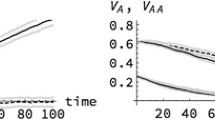Abstract
I determine the second-order approximation for the phenotypic distribution of a quantitative trait, ignoring the effects of epistasis and linkage disequilibrium, conditioned on the presence of a specified genotype at one underlying locus of small effect. I demonstrate that this approximation has an error that is third order in the allelic or genotypic effects, independent of the form of the phenotypic distribution. I also show that the approximation of analogous form for the phenotypic distribution conditioned on the presence of a specified allele at a single locus is also correct to second order. Both approximations allow for dominance and are consistent in the sense that computing marginal fitnesses from approximations based on genotypic deviations and those based on average allelic effect yield the same answers. Surprisingly, the second-order approximations derived here yield the same approximation for dynamics at a single locus as first-order approximations used earlier thus justifiying earlier stability computations based on these first-order approximations.
Similar content being viewed by others
References
Barton, N. H.: The maintenance of polygenic variation through a balance between mutation and stabilizing selection. Genet. Res. 47, 209–216 (1986)
Barton, N. H., Turelli, M.: Adaptive landscapes, genetic distance and the evolution of quantitative characters. Genet. Res. 49, 157–173 (1987)
Bulmer, M. G.: The stability of equilibria under selection. Heredity 27, 157–162 (1971)
Bulmer, M. G.: The genetic variability of polygenic characters under optimizing selection, mutation, and drift. Genet. Res. 19, 17–25 (1972)
Falconer, D. S.: A note on Fisher's ‘average effect’ and ‘average excess’. Genet. Res. 46, 337–347 (1985)
Feller, W.: An introduction to probability theory and its applications, vol. 2, 2nd edn. New York: Wiley 1971
Fisher, R. A.: The correlation between relatives on the supposition of Mendelian inheritance. Trans. Roy. Soc. Edinb. 52, 399–433 (1918)
Fisher, R. A.: The genetical theory of natural selection. Oxford: Clarendon Press 1930
Kimura, M.: Possibility of extensive neutral evolution under stabilizing selection with special reference to nonrandom usage of synonomous codons. Proc. Natl. Acad. Sci., USA d78, 6168–6171 (1981)
Kimura, M., Crow, J. F.: Effect of overall phenotypic selection on genetic change at individual loci. Proc. Natl. Acad. Sci., USA 75, 6168–6171 (1978)
Nagylaki, T.: Selection on a quantitative character. In: Chakravarti, A. (ed.) Human population genetics: The Pittsburgh Symposium, pp. 275–306. New York: Van Nostrand Reinhold 1984
Turelli, M.: Phenotypic evolution, constant covariances, and the maintenance of additive variance. Evolution 42, 1342–1347 (1988)
Walsh, J. B.: Inconsistencies in standard approximations for selection coefficients at polygenic loci. J. Math. Biol. 28, 21–31 (1990)
Author information
Authors and Affiliations
Rights and permissions
About this article
Cite this article
Hastings, A. Second-order approximations for selection coefficients at polygenic loci. J. Math. Biol. 28, 475–483 (1990). https://doi.org/10.1007/BF00178330
Received:
Revised:
Issue Date:
DOI: https://doi.org/10.1007/BF00178330



